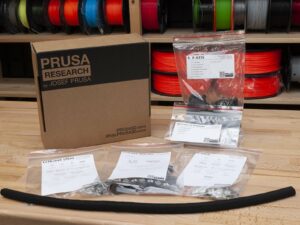English
1. Preparing the upgrade kit
Step 1 of 14 (Chapter 1 of 7)
Contents
Comments
⬢Welcome to the tutorial how to upgrade your Original Prusa i3 MK3/MK3S to Original Prusa i3 MK3S+
⬢Please prepare the upgrade kit received from Prusa Research.
WARNING: Before you start disassembling the printer, make sure you have printed all the necessary parts for the upgrade!!!
Download all necessary parts on prusa3d.com/printable-parts.
This assembly guide is valid only while upgrading your printer to a SINGLE MATERIAL MK3S+
Loading...


Contents
Original Prusa i3 MK3/MK3S to MK3S+ upgrade
- 1. Introduction
- Preparing the upgrade kit
- What will be updated?
- Getting the necessary tools
- Labels guide
- Use labels for reference
- View high resolution images
- Printed parts - versioning
- Printed parts - self printing
- Printed parts post-processing
- We are here for you!
- Pro tip: inserting the nuts
- Important: Electronics protection
- How to successfully finish the assembly
- Choose your printer
- 2A. MK3 Extruder disassembly
- 3A. MK3 Extruder upgrade
- 3B. MK3S Extruder upgrade
- 4. Electronics assembly
- 5. Y-axis upgrade
- 6. Preflight check
I printed the parts out on my mk3s with Galaxy Black prior to purchasing the kit and liked how they turned out, but due to the comments on needing a very dark filament, I wasn't sure if it would cause problems with the infrared filament sensor or not.
I'd like to use the Galaxy Black, because the parts printed better AND they look a lot more similar to the color of the mk4s extruder shroud and other extruder parts.
You can find all the parts here https://www.printables.com/model/61346-i3-mk3s-to-mk3s-upgrade-printable-parts
If you wish only to modify the extruder, then you would require to purchase the shorter PTFE tube specifically for the MK3S+, while the plastic parts can be printed. The files are available here: https://www.prusa3d.com/prusa-i3-printable-parts/
I've printed fs-cover-mmu2s.stl, but I don't have the M5 threaded insert for the tube fitting.
I've found in a comment elsewhere on this site that the part is a "Tappex Microbarb 300126531 0006-M5". Can you confirm this is the correct part?
What is the process for installing this into the printed part? Is it just pressed into place, or do I need to warm it first?
Hi! Yes, that's the actual threaded insert used. Usually, these inserts are being DIY installed using a soldering iron. It is important that the insert is perfectly lined up. That's the reason why Prusa doesn't sell the inserts alone.
"WARNING: Before you start disassembling the printer, make sure you have printed all the necessary parts for the upgrade!!!
"If you have the MMU2 You must print the MMU2S upgrade parts before before starting the upgrade!!!"
BTW shouldn't you also label those new parts "MMU2S+ parts" if the "pre-MK3S+" MMU2S need updating?
I spent 1/2 day and tech supports time trying to figure out why my filament wouldn't reach teh extruder.